Measuring the hallmarks of ageing – how can you track the underlying causes of ageing?
What consumer tests are available to check your hallmarks of ageing and how they're impacting your body?
Join the club for FREE to access the whole archive and other member benefits.
At my last blood donation appointment, I was unfortunately told I could not donate due to a low haemoglobin result. It wasn’t bad enough to refer me to my GP, but not good enough to be given to people in need of healthy blood. The finger prick test had failed, with my blood drop failing to fall to the bottom of the tube of copper sulphate solution. To double check, they then performed a proper analysis and the result of that was 134 g/L – it has to be at least 135 to donate.
Jump straight to blood test comparison
In fact, this was the second time in a row it had happened (you can’t try again for 3 months) so I thought I’d better investigate. I pulled out my old blood test results (I really must put them into an online system, aka the cloud, one day) and noticed that, although it has always been reasonably low, my haemoglobin level has dropped significantly in the last couple of years. Inexcusably, the report that comes with the blood test has, for the last two times, highlighted potential anaemia and recommended I speak to a doctor.
My Medichecks* results have four iron status readings as well as another seven for red blood cells, so I thought I’d try to summarise what each of the different types of iron blood tests measure.
Before looking at the different types of iron blood tests available, it’s important to have a basic understanding of the body’s iron cycle. Importantly, most iron is recycled within the body so any adverse changes to diet or absorption can take some time to show any symptoms. The average body contains around 4 grams of iron, however, only 1 to 2 mg of iron are lost each day mainly from natural loss of skin and gastrointestinal cells. This is the amount that needs replacing from dietary sources.
At a high-level, the main steps taken by iron in the body are:
1. Consume food containing iron
2. Some of this is absorbed in the gut into the blood stream
- some medical conditions can mean iron is not easily absorbed
- very little free-floating iron is present in the blood stream because…
3. Transferrin binds to the iron and transports it into cells
- approximately 75% is used to create red blood cells (RBCs) in bone marrow
- 10-20% goes to liver (stored in ferritin)
- the rest is stored in various cells in the body (again within ferritin)
- released back into blood plasma as required – regulated by hepcidin
4. Each red blood cell contains 250 million haemoglobin molecules
- each of which contains four iron atoms which is where oxygen binds to as the RBCs circulate
- the oxygen is picked up in the lungs then diffused to other cells via capillaries
5. Old or damaged RBCs broken down in the spleen and the iron is recycled
- a typical RBC circulates once a minute and survives for four months
From this summary, hopefully it’s possible to see that the amount of iron consumed is not the only factor in anaemia, and hence a range of blood iron tests are needed to pin point the exact location of the problem.
So, the first thing to note is that not all blood iron tests are the same. There are tests for different parts of the blood iron cycle, all of which may be marketed as either iron or anaemia tests. Importantly, some measure a single component, whereas others measure a several which give a better perspective of your iron metabolism.
Secondly, and surprisingly, blood iron (aka serum iron) is no longer the standard test for anaemia. Ferritin, which determines the amount of stored iron in the body, is now considered to be a better indicator of iron deficiency, though in some cases a blood iron test may be ordered at the same time to determine whether any problems may be caused by a long-term illness.
Ferritin is a protein that stores iron in the body. It is mostly found in tissues, with small amounts circulating in the blood acting as an iron carrier. Ferritin concentration in the blood gives a good indication of the amount of iron stored in the body.
High ferritin levels can also be caused by inflammatory conditions and liver disease; therefore, some iron profile tests include a high sensitivity CRP test to check whether the ferritin level could be affected by infection or inflammation.
Sample: blood (arm vein or finger-prick)
Preparation: Possible 12-hour fast
Normal range: 15 - 300 (male), 10 - 300 (female) ng/mL (nanograms per millilitre)
ng/mL is the same as μg/L which is an alternate unit for this test.
Haemoglobin is the component of red blood cells that transports oxygen, from the lungs to the cells, by binding it to one of its four iron atoms.
Low haemoglobin levels mean you have anaemia. High haemoglobin levels indicate polycythaemia (too many red cells).
Sample: blood (arm vein or finger-prick)
Preparation: None (but properly hydrated)
Normal range: 130-180 (male), 115-165 (female) g/L (grams per litre)
Though you are unlikely to see symptoms, if otherwise healthy, until level falls below 100.
Red blood cells (also known as erythroid cells or erythrocytes) carry oxygen from the lungs to the body’s cells. The oxygen is stored in one of the millions of haemoglobin molecules that each RBC contains.
Around 40-45% of blood, by volume, is red blood cells.
Sample: blood (vein)
Preparation: None
Normal range: 4.5-6.5 (male), 3.8-5.8 (female) 10^12/L (trillions per litre)
People are considered anaemic when their RBC is 10% below the normal range.
Low counts may also be due to nutritional deficiencies of iron, folate and vitamin B12.
High counts may be due to living at high altitudes where less oxygen is available.
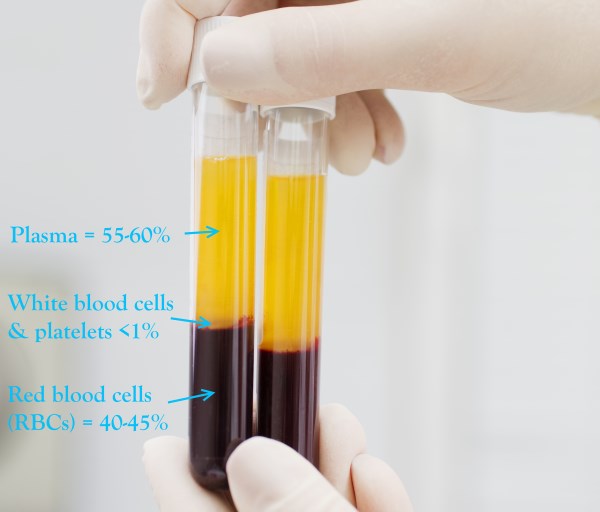
The average size of red blood cells is measured by an MCV (mean corpuscular volume) blood test. Interestingly, because of the biconcave shape of red blood cells, they have a greater surface area than a sphere of the same diameter. This provides a larger surface for the exchange of gases.
Sample: blood (vein)
Preparation: None
Normal range: 80-100 fl (femtolitres, i.e. 10^-15 litres) *may vary with age
Smaller than normal RBCs may indicate anaemia.
Larger than normal RBCs may indicate a deficiency in vitamin B12 or folic acid.
Serum iron tests are no longer performed routinely with most healthcare providers now recommending ferritin as the primary test for body iron levels. However, testing for free iron in blood is still available, and is sometimes included in a profile test.
Sample type: blood (vein)
Preparation: 12 hour fast
Normal range: 11 - 38 µmol/L (60 – 210 µg/dL)
Serum Iron conversion: µg/dL = 5.586 x µmol/L
This test measures the amount of transferrin in the blood that is available to bind to iron atoms. Transferrin is a protein that transports iron through-out the body, for example, from the blood to bone marrow to create RBCs. The transferrin saturation value is calculated by dividing serum iron level (i.e. the amount of iron in the blood) by the total iron-binding capacity (TIBC).
Sample type: blood (vein)
Preparation: 12 hour fast
Normal range: 25 percent to 35 percent
So, after my recent haemoglobin warning, I combined all my results together – from private blood tests, NHS tests and the blood donor refusal figures. It turns out my red blood cell count has always been a bit low, compensated for by higher volumes, and has remained relatively steady, compared to the sudden drop off on the other results.
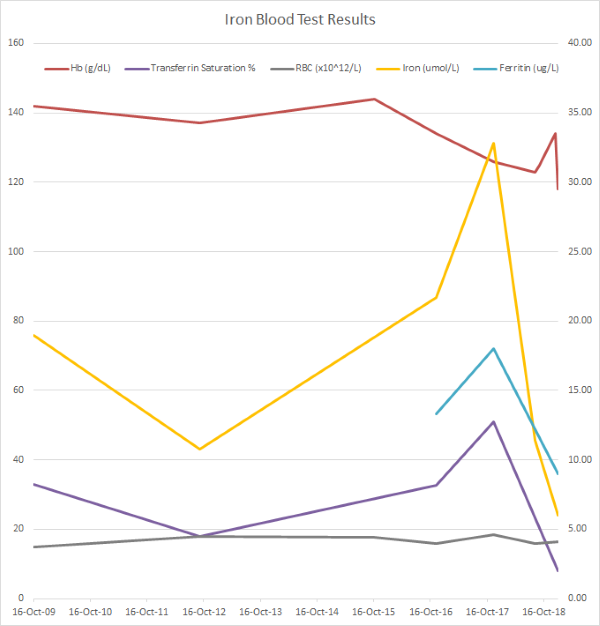
I’ve decided I’d better see my GP, but in the meantime (and also to monitor any impact of prescriptions and/or treatments) I’ll continue to check my blood iron profile regularly.
There is a range of kits and companies available in the UK that provide varying levels of blood iron tests, so I thought I’d review what they each have to offer. They start at basic yes/no results for anaemia (based on a threshold level for ferritin) all the way up to a full blood profile which include multiple tests. The cheaper tests give a quick yes/no result at home, whereas other required a finger prick blood sample (equipment provided) to be sent by post to their laboratory.
Perhaps if you’re just being curious, or have minor symptoms of anaemia (e.g. tiredness, heart palpitations) then start with a cheap home kit, and if that indicates a problem then try a more detailed test. Also, if you’re interested in seeing how different interventions (e.g. diet changes, iron supplements) affect your blood iron level then the test will need to provide a quantitative reading (i.e. a number that can be tracked). For my slightly more intensive monitoring I’ll be selecting a middle of the range test that is affordable to purchase on a regular basis.
Here’s a summary of the main UK blood iron test providers. More details about each one below.

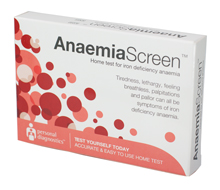
Type: Home test kit – immediate result
Cost: £7.99
Provides a simple pass/fail based on a ferritin level of 20 ng/ml. Enough to highlight whether you should see your GP.
More details: https://personaldiagnostics.co.uk/Products/AnaemiaScreen.html

Type: Finger prick – post for analysis
Cost: £79
The Iron Status Profile includes four tests: ferritin, serum iron, TIBC and transferrin saturation.
It’s basically the same as the Medichecks test, but twice the price.
More details: https://bluehorizonmedicals.co.uk/iron-status-profile-bhm.html
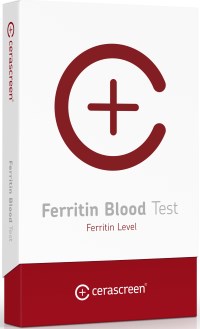
Type: Finger prick – post for analysis
Cost: £34
Comes with an informative 11-page report, but actually only tests for ferritin level. However, it does provide the actual ferritin value unlike most cheaper ferritin tests than only provide a positive or negative reading. But for £5 more the Medichecks test provides a complete iron profile.
More details: https://www.cerascreen.co.uk/products/ferritin-blood-test

Type: Finger prick – post for analysis
Cost: £39
The Iron Deficiency Check includes five tests: C-reactive protein, ferritin, serum iron, TIBC and transferrin saturation. The high sensitivity CRP (CRP-hs) test is part of the package to determine whether raised inflammation (which also raises ferritin levels) is masking a low result.
Medichecks also offer UltraVit tests that also include haematology profiles (e.g. red blood cell count and volume). They costs £149 (though is often on offer) so too expensive for a regular test for blood iron, but if you’re just doing a one-off health test then this is worth considering.
More details: https://www.medichecks.com/iron-tests/iron-deficiency-check*

Type: Vein blood sample at hospital
Cost: £89 + £25 GP referral
The Anaemia Profile includes Full Blood Count, Erythrocyte Sedimentation Rate (ESR), Iron, IBC, Ferritin, Vitamin B12, Folic Acid. ESR is an inflammation marker to check that the ferritin result isn’t being skewed by other factors.
Although the most comprehensive blood iron test on the list, by the time the referral fee is added on (which none of the other providers require) the price is getting closer to what I’d expect to pay for a full health profile test.
More details: https://www.nuffieldhealth.com/pathology-direct
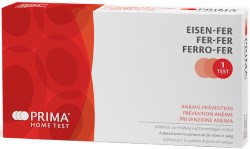
Type: Home test kit – immediate result
Cost: £11.99
The IRON Fer Test provides a simple pass/fail based on a ferritin level of 20 ng/ml. Enough to highlight whether you should see your GP. This product is sometimes listed online as an anaemia test.
More details: https://www.amazon.co.uk/Prima-Home-Test-Iron-Tester/dp/B005CTTXXO*

Type: Finger prick – post for analysis
Cost: £49
The only iron profile test available from Thriva is ferritin but the Baseline test also includes cholesterol, liver function, vitamin D and B12. So, if you’re interested in those other tests then this could be good value for money. And 50% discount codes are regularly available for your first test.
More details: https://thriva.co/products/baseline
Lab Tests Online – authoritative and independent information
https://labtestsonline.org.uk/tests/iron-tests
NHS - Haematology Normal Adult Reference Ranges
https://www.royalwolverhampton.nhs.uk/services/service-directory-a-z/pathology-services/departments/haematology/haematology-normal-adult-reference-ranges/
NHS – anaemia information
Vitamin B12 or folate deficiency anaemia
https://www.nhs.uk/conditions/vitamin-b12-or-folate-deficiency-anaemia/
Iron deficiency anaemia
https://www.nhs.uk/conditions/iron-deficiency-anaemia/
Armando Hasudungan - Iron Physiology explainer video
YouTube - https://www.youtube.com/watch?v=ahCy97FVUpM
Detailed whiteboarding of iron physiology from dietary intake, through maturing red blood cells to eventual release by macrophages in the spleen.
NOTES
For our US readers, anemia is spelt anaemia in the UK – it’s not a typo!
Plasma image © Adobe Stock / Fly_dragonfly
Click on resource name for more details.
Live Forever Manual Reviews
Stanford University optimistic about human rejuvenation
What consumer tests are available to check your hallmarks of ageing and how they're impacting your body?
A good jump in NAD levels and grip strength during this one month trial, but not everything improved
What is the impact on physical biomarkers from taking spermidine supplements?
2 month trial of nicotinamide riboside NAD booster Tru Niagen